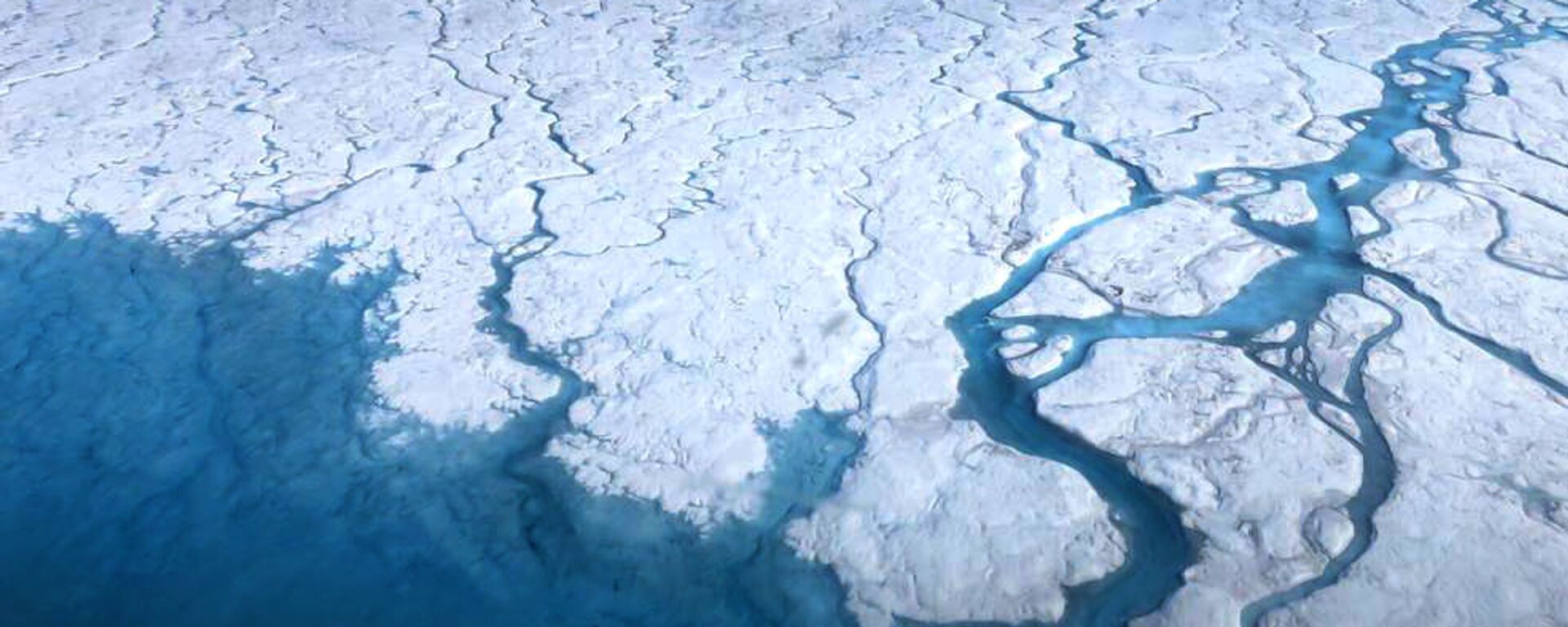https://sputnikglobe.com/20221122/greenland-ice-getting-darker-melting-faster-due-to-pigmented-algae-1104523697.html
Greenland Ice Getting Darker, Melting Faster Due to Pigmented Algae, Researchers Say
Greenland Ice Getting Darker, Melting Faster Due to Pigmented Algae, Researchers Say
Sputnik International
In theory, the entire ice sheet of Greenland, the world’s largest island, contains enough water to raise sea levels by more than seven meters. 22.11.2022, Sputnik International
2022-11-22T08:32+0000
2022-11-22T08:32+0000
2022-11-22T08:40+0000
environment
greenland
ice
global warming
climate change
science & tech
https://cdn1.img.sputnikglobe.com/img/07e4/0c/09/1081407656_0:318:3073:2047_1920x0_80_0_0_486434edd05b571d9142ce4873250b45.jpg
A thin layer of blooming pigmented algae that darkens the surface of Greenland’s glaciers and ice sheets, coloring them brown-grey, has been identified as one of the reasons the ice is melting faster.The algae growing on the white snow cannot be distinguished with the naked eye and can only be seen through a researcher's microscope. However, their colonies spread on ice and packed snow and to an untrained viewer resemble pollution. They absorb sunlight and, through photosynthesis, convert it into energy.Global warming and rising temperatures were previously reported to have shortened the snow season in Greenland. The white snow melts away earlier than before, leaving the ice bare for longer. This means that the algae colonies on the ice now have more time to grow. In turn, the ice becomes darker and absorbs more heat from the sunrays even more effectively.According to Halbach, the hope is that the new knowledge will allow researchers to better quantify the impact from the algae on ice melting and better reflect it in climate models.Earlier this fall, observations from Northeast Greenland indicated an up to six times higher flow of meltwater from the island’s key area than previously thought. Researchers from the Technical University of Denmark warned that similar underestimations may have occurred in other places, which may lead to drastic miscalculations of the entire climate situation, as well the process of working out measures to counter it.Located between the Arctic and Atlantic oceans to the east of the Canadian Arctic Archipelago, sparsely-populated Greenland, one of the three constituent countries of the Danish Realm alongside Denmark proper and the Faroe Islands, is the world's largest island.In theory, Greenland’s entire ice sheet contains enough water to raise the oceans by more than seven meters.
https://sputnikglobe.com/20221116/greenland-ice-melting-six-times-faster-than-thought-danish-researchers-say-1104271094.html
greenland
Sputnik International
feedback@sputniknews.com
+74956456601
MIA „Rossiya Segodnya“
2022
News
en_EN
Sputnik International
feedback@sputniknews.com
+74956456601
MIA „Rossiya Segodnya“
Sputnik International
feedback@sputniknews.com
+74956456601
MIA „Rossiya Segodnya“
pigmented algae, dark ice, greenland ice, global warming, climate change, rising sea levels
pigmented algae, dark ice, greenland ice, global warming, climate change, rising sea levels
Greenland Ice Getting Darker, Melting Faster Due to Pigmented Algae, Researchers Say
08:32 GMT 22.11.2022 (Updated: 08:40 GMT 22.11.2022) In theory, the entire ice sheet of Greenland, the world’s largest island, contains enough water to raise sea levels by more than seven meters.
A thin layer of blooming pigmented algae that darkens the surface of Greenland’s glaciers and ice sheets, coloring them brown-grey, has been identified as one of the reasons the ice is melting faster.
The algae growing on the white snow cannot be distinguished with the naked eye and can only be seen through a researcher's microscope. However, their colonies spread on ice and packed snow and to an untrained viewer resemble pollution. They absorb sunlight and, through photosynthesis, convert it into energy.
“We have seen that Greenland's ice sheet has become darker”, Laura Halbach, an Arctic microbiologist at Aarhus University in Denmark and part of the international research crew, told Swedish media. “The algae that grow on the ice itself absorb light energy five times more efficiently than algae that grow on snow,” she added.
Global warming and rising temperatures were previously reported to have shortened the snow season in Greenland. The white snow melts away earlier than before, leaving the ice bare for longer. This means that the algae colonies on the ice now have more time to grow. In turn, the ice becomes darker and absorbs more heat from the sunrays even more effectively.
According to Halbach, the hope is that the new knowledge will allow researchers to better quantify the impact from the algae on ice melting and better reflect it in climate models.

16 November 2022, 07:31 GMT
Earlier this fall, observations from Northeast Greenland indicated an up to six times higher flow of meltwater from the island’s key area than previously thought. Researchers from the Technical University of Denmark warned that similar underestimations may have occurred in other places, which may lead to drastic miscalculations of the entire climate situation, as well the process of working out measures to counter it.
Located between the Arctic and Atlantic oceans to the east of the Canadian Arctic Archipelago, sparsely-populated Greenland, one of the three constituent countries of the Danish Realm alongside Denmark proper and the Faroe Islands, is the world's largest island.
In theory, Greenland’s entire ice sheet contains enough water to raise the oceans by more than seven meters.


